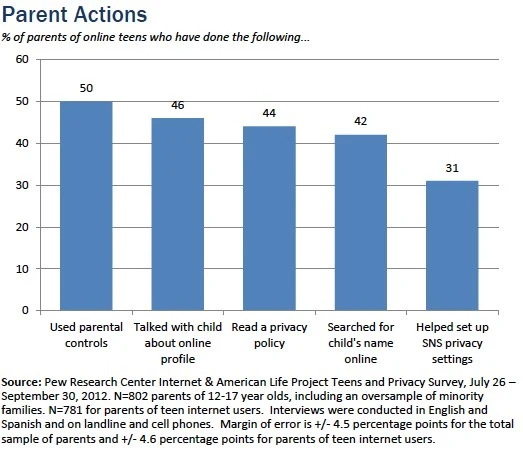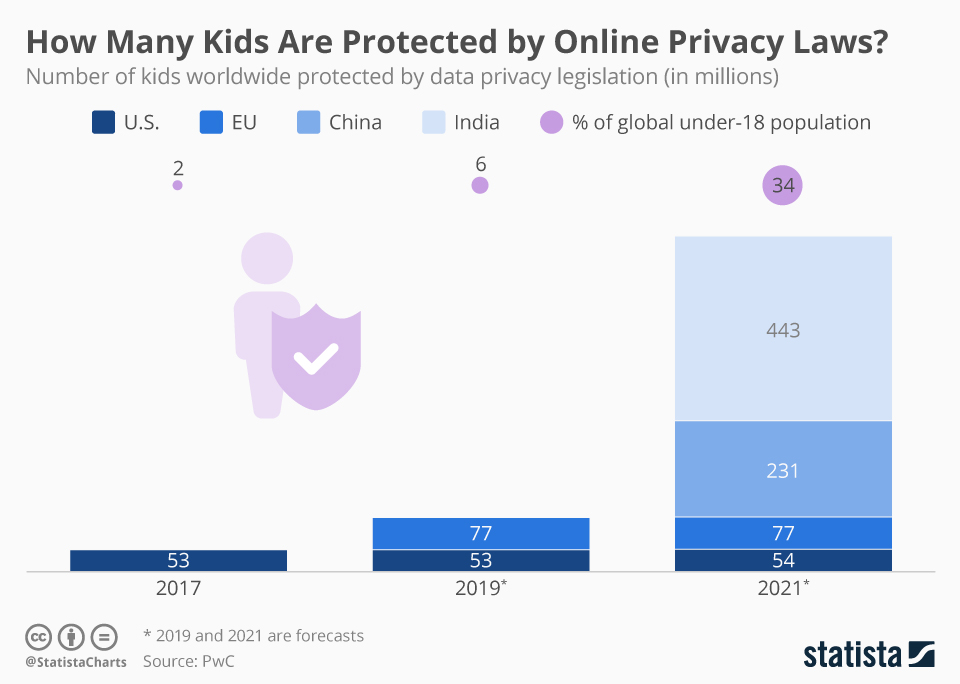The Growing Concerns of Child and Teenage Privacy in the Age of AI and Modern Internet

Learn about the growing concern of child privacy in the age of AI and the modern internet, and discover steps to protect your children online.
With the advent of modern technology and the increasing prevalence of Artificial Intelligence (AI), the issue of privacy has become more critical than ever, especially for children and teenagers. The Internet has transformed the way we live, work, and interact, but it has also brought new challenges for parents and guardians.
Children and teenagers are more vulnerable to privacy breaches due to their limited understanding of online safety and the lack of proper guidance.
In this article, we will discuss how AI and modern internet can affect a child’s privacy, highlight some of the real cyber incidents and cases, and provide recommendations for parents and guardians to safeguard their children’s privacy.
The Impact of AI and Modern Internet on Child Privacy:
AI and modern internet have revolutionized the way companies collect and use personal data. Companies use sophisticated algorithms to track user behavior, preferences, and online activities. They collect data from multiple sources, including social media platforms, search engines, mobile apps, and websites, to create detailed profiles of their users.
Children and teenagers are among the most active users of the internet and social media. They share a significant amount of personal information online, including their name, age, location, and interests.
This information can be used by companies to target them with personalized ads, content, and offers. While some of these ads may be harmless, others may contain inappropriate or harmful content. Child privacy need to be a top priority to ensure a peaceful life for next generation.
Real Cyber Incidents and Cases:
There have been several incidents and cases where children’s privacy has been compromised due to the misuse of personal data by companies and individuals. Let’s look at some of the cases where Child Privacy was a major concern.
- TikTok Data Privacy Breach: In 2020, the popular social media app, TikTok, was fined $5.7 million for collecting and storing personal information of children under the age of 13 without parental consent. The app, which is popular among teenagers, collected data such as email addresses, phone numbers, and location data, which could be used for targeted advertising.
- Cambridge Analytica Scandal: In 2018, Facebook faced a major privacy scandal after it was revealed that the political consulting firm Cambridge Analytica had harvested the personal data of millions of Facebook users without their consent. The data was used to influence the 2016 US presidential election. Children and teenagers were among the affected users.
- Fortnite Data Breach: In 2018, the popular video game, Fortnite, suffered a data breach that exposed the personal data of millions of users. The breach included usernames, passwords, and email addresses. Children and teenagers were among the affected users.
These incidents demonstrate the vulnerability of child privacy and highlight the importance of taking measures to safeguard their personal data.
Status of Child and Teenage Privacy
Internet privacy is a significant concern for children and teenagers. A number of studies have been conducted to assess the impact of internet privacy on children and teenagers. Here are some key findings:

- Pew Research Center: According to a 2018 survey by the Pew Research Center, 45% of US teens (aged 13-17) reported being online “almost constantly”, while another 44% said they go online several times a day. The survey also found that 97% of US teens use a social media platform.
- Common Sense Media: In a 2020 report by Common Sense Media, it was found that 53% of US teens (aged 13-17) feel addicted to their mobile devices, while 41% say they spend too much time on their mobile devices. The report also found that 59% of US parents worry about their children’s online privacy.
- JAMA Pediatrics: A study published in JAMA Pediatrics in 2019 found that over half of US parents (57%) reported concerns about their child’s online privacy, while 49% said they were concerned about their child’s safety on the internet.
- UNICEF: According to a report by UNICEF in 2017, children are increasingly exposed to risks online, such as cyberbullying, online harassment, and exposure to inappropriate content. The report found that around 71% of children aged 15-24 years old in 25 countries use social media, and that 1 in 3 internet users are children.
- Office of the Children’s eSafety Commissioner: In Australia, the Office of the Children’s eSafety Commissioner found that cyberbullying is a significant concern for children and teenagers. A 2018 survey found that 1 in 5 Australian children aged 8-17 experienced cyberbullying in the previous year, while 1 in 4 reported witnessing it happening to someone else.

The data suggests that internet privacy is a significant concern for children and teenagers. While the internet offers many benefits, such as increased connectivity and access to information, it also poses risks to their privacy and safety. It is essential for parents and guardians to take measures to protect their children’s privacy online, such as monitoring their social media activities and using privacy settings.
Child Privacy Recommendations for Parents and Guardians:
As a parent or guardian, there are several steps you can take to safeguard your child’s privacy online. Here are some recommendations:
- Educate your child about online safety: Teach your child about the risks of sharing personal information online and the importance of maintaining privacy. Discuss the potential consequences of sharing inappropriate content or engaging in risky behavior online.
- Use parental controls: Use parental controls and privacy settings on devices and social media accounts to limit the amount of personal information that can be shared online. Make sure your child’s accounts are set to private and that only friends and family can view their content. Employing VPNs can also bring some extra control over exposure to internet.
- Monitor your child’s online activities: Keep an eye on your child’s online activities and regularly check their search history and social media accounts. Look for any signs of inappropriate or risky behavior and address them immediately.
- Use secure passwords: Encourage your child to use strong and unique passwords for all their accounts. Consider using a password manager to help them create and manage their passwords.
- Limit screen time: Set limits on your child’s screen time to reduce their exposure to potentially harmful content and to encourage them to engage in other activities.
- Talk to your child about AI: Discuss the basics of AI and how it is used to collect and analyze personal data. Encourage your child to be mindful of the information they share online and to think critically about the content they see.
Securing Child and Teenage Privacy in Social Media Platforms
Social media platforms have become an integral part of our lives, especially for children and teenagers. While these platforms can be fun and entertaining, they can also pose significant risks to the privacy of children and teenagers.
In this section, we’ll discuss some settings and steps that can help parents and guardians secure the privacy of their children on social media.
Understand the privacy policy of social media platforms:
Before allowing your child to use a social media platform, it’s important to read and understand the platform’s privacy policy. This will give you an idea of how the platform collects, uses, and shares personal data. Some platforms may also have specific privacy settings that can be adjusted to better protect your child’s privacy.
Enable privacy settings:
Most social media platforms have privacy settings that can be used to control who can see your child’s profile and content. For example, you can set the profile to private, which means only approved followers can see their posts.
You can also control who can see individual posts by adjusting the privacy settings for each post. Make sure you go through the privacy settings on each platform and choose the appropriate settings for your child.
Use strong passwords:
Using a strong and unique password is an essential step in securing your child’s privacy. A strong password should be at least 12 characters long and include a mix of letters, numbers, and symbols. Avoid using common words or phrases that can be easily guessed. It’s also important to use a different password for each social media account.
Monitor your child’s social media activities:
It’s important to monitor your child’s social media activities to ensure they are using the platforms safely and responsibly. Keep an eye on their friends and followers, as well as the content they are posting and interacting with. This can help you identify any potentially dangerous or inappropriate behavior and take action before it becomes a problem.
Educate your child on online safety:
Teach your child about the risks and dangers of social media and how to stay safe online. Encourage them to think before they post or share any personal information and to be wary of strangers online. Explain to them the importance of privacy and why it’s essential to protect their personal information.
Limit screen time:
Set limits on your child’s screen time to reduce their exposure to potentially harmful content and to encourage them to engage in other activities.
Use parental control apps:
There are many parental control apps available that can be used to monitor your child’s social media activities and ensure they are using the platforms safely. These apps can be used to set time limits, block inappropriate content, and monitor their online behavior.
Social media platforms can be a great way for children and teenagers to connect with their friends and share their interests, but they also pose significant risks to their privacy.
By understanding the privacy policy of social media platforms, enabling privacy settings, using strong passwords, monitoring your child’s social media activities, educating them on online safety, limiting screen time, and using parental control apps, parents and guardians can help ensure that their child’s privacy is protected on social media platforms. It is essential to take these measures seriously to protect children and teenagers from the risks of privacy breaches and online dangers.
Protect your Child Privacy before its too late
AI and modern internet have revolutionized the way companies collect and use personal data, and this has significant implications for the privacy of children and teenagers. While there are laws and regulations in place to protect children’s privacy, parents and guardians also have a role to play in safeguarding their children’s personal data.
By educating children about online safety, using parental controls and privacy settings, monitoring their online activities, using secure passwords, limiting screen time, and talking to them about AI, parents and guardians can help ensure that their children’s privacy is protected in the age of AI and modern internet.
It is essential to take these measures seriously to protect children and teenagers from the risks of privacy breaches and online dangers.
Subscribe to our newsletter for daily alerts on cyber events, you can also follow us on Facebook, Linkedin, and Twitter. You can reach out to us via Twitter/ Facebook or mail us at admin@thecybersecuritytimes.com for advertising requests.








